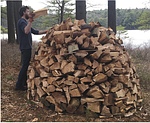The Zen of Woodpiles
Expecting to read up on the Beatles, I pulled a book called Norwegian Wood off the shelf at the Birch Bark Bookstore in Minneapolis several years ago, only to discover that it was literally a book about chopping, stacking, and drying wood. Good information, coming from a nation where the holiday broadcast of a crackling fireplace draws the Norwegian TV network’s highest volume of complaints every year. Thousands of flustered viewers feel that the logs are not being placed onto the flames correctly.
Each spring, wood piles rise up in lines and cubes, in jumbled circles, in open squares or closed ones, shaped as towers, beehives, or fish in rural back yards all over Scandinavia. The split logs dry over the summer. Then, like Buddhist sand paintings, the shapes disperse into the winter wind as smoke from cozy Norwegian stoves and fireplaces. Inspired by the sensuous photographs of these sculptural masterpieces, I immediately bought the book for my husband, a dedicated woodsman who owns chainsaws in three sizes.
The elaborate woodpiles remained aspirational for us until the pandemic hit. During the first tense months of the lockdown in April 2020, our two sons were trapped nearby in a Jersey City apartment. Free and restless labor! Rex decided on the spot to build a firepit. To feed it, we would break up the carcass of an enormous hemlock tree, five feet in diameter, that had died several years earlier and been taken down by the famous and late-lamented Lincoln Colwell.
The project carried us through the worst of the lockdown. Each weekend, my husband sawed and sawed, creating dozens of giant coins 18” thick and five feet across. The boys whacked them into burnable chunks with go-devils, sledgehammers and wedges. We marked out a circle and I began to stack a spiral, rising row of the most perfect pieces. The odd shapes with knots were tossed into the middle for support. The pile would be in the shape of a beehive. First building straight up, then carefully slanting the higher rows inwards, I found it surprisingly easy to get the symmetry right. My oldest son reached across and jammed a final, thick piece into the top, making a keystone for the perfectly dome-shaped top. Ta-Dah!
Two years later, it’s all gone.


